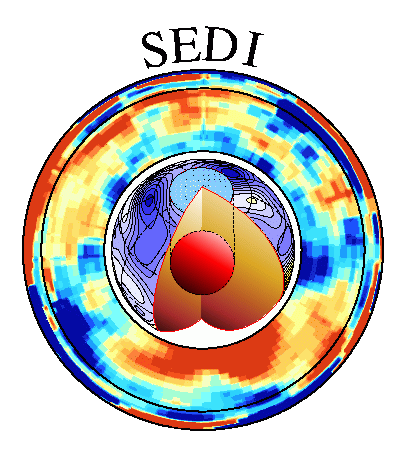The Doornbos Memorial Prize is presented to a young scientist by the Committee
on Studies of the Earth's Deep Interior (SEDI), in association with their
biennial meetings, for outstanding work on the Earth's deep interior. It is
given in honor of the Dutch seismologist, Durk Doornbos.
| Prizewinner | |
|---|---|
| 1994 | |
| R. E. Cohen | |
| R. Hollerbach | |
| J. Tromp | |
| 1996 | |
| R. van der Hilst | |
| X. Song | |
| S. Widiyantoro | |
| 1998 | |
| D. Andrault | |
| A. Tilgner | |
| L. Vocadlo | |
| 2000 | |
| M. Bergman | |
| E. Dormy | |
| I. Sumita | |
| 2002 | |
| D. Alfe | |
| R. Holme | |
| S. Labrosse | |
| 2004 | |
| A. Deuss | |
| C. Farnetani | |
| 2006 | |
| J. Aubert | |
| K.Koper | |
| J. Mound | |
| 2008 | |
| N. Gillet | |
| J. Hernlund | |
| L. Li | |
| Prizewinner | Recognized for |
|---|---|
| 2010 | |
| M. Le Bars | pioneering laboratory models of planetary mantle and core fluid dynamics |
| D. Shim | systematic studies of mineral phase transformations and thermoelastic properties at high temperatures and pressures, with an emphasis on elucidating the role of the post-perovskite transformation in the deep mantle |
| J. Wookey | innovative analysis of seismic data to reveal seismic anisotropic structure, with a view to constraining physical mechanisms of deformation and fabric formation in the Earth's deep interior |
| 2012 | |
| R. Deguen | his particularly innovative contributions to understanding the dynamics and evolution of the inner core and its interactions with the surrounding fluid. |
| C. Finlay | theoretical and applied contributions to understanding the nature and source of the geodynamo secular variation, and unselfish cooperation in research. |
| 2014 | |
| N. Schmerr | cross-disciplinary studies into the detailed natures of seismic discontinuities in the upper mantle, which give new views to mineralogical interpretation and their dynamical relationship with surface tectonic features of the Earth. |
| K. Ohta | outstanding experimental studies on phase transitions, thermal and electrical conductivities of materials in the lowermost mantle at high temperatures and pressures, which constrain strongly the interpretation of the dynamics of the core-mantle boundary region. |
| B. Sreenivasan | fundamental contributions to our understanding of vortex dynamics and magnetic field stability in dynamo system and applications to the Earth's core. |
| 2016 | |
| C. Davies | linking core dynamics to paleomagnetic observations and seminal work on the geophysical implications of deep earth diffusivities. |
| K. Hori | novel studies of core physics, including the development of a new tool to give us an independent source of information about the geomagnetic field. |
| S. Tateno | cutting edge experimental studies of the structure of deep Earth minerals made over the entire range of deep Earth conditions. |
| 2018 | |
| P. Koelemeijer | careful and broad analysis of body and normal mode seismic data, integrated with mineral physics to constrain the state and dynamics of the lowermost mantle. |
| M. Landeau | innovative laboratory experiments on core formation and for numerical dynamo models that link past history of the geomagnetic field to the evolution of the core. |
| R. Nomura | development and execution of high pressure experiments that improve our understanding of melting and deformation of Earth's mantle and core. |
| 2022 | |
| Mathieau Bouffard | For conceptual and numerical advances on the transport of chemical heterogeneities in planetary cores and the dynamics of stratified layers. |
| Charles-Édouard Boukaré | For innovative thermodynamics and multi-phase fluid dynamics models of magma ocean crystallisation. |
| Rebecca Fisher | For the outstanding combination of high pressure experimental studies and planetary scale modelling to problems related to planetary formation, differentiation and the composition. of the deep interior of Earth and the planets |
| Dan Frost | Recognised for innovative techniques to image Earth’s small-scale structure and cross-disciplinary studies linking seismic observations to geodynamics and mineralphysics to constrain the structure of Earth’s core. |
| Yufeng Lin | Yufeng Lin has been working on a broad range of Geophysical-Astrophysical fluid dynamics problems, from Earth and planetary dynamos to tidal dissipation in stars, combining experiments, numerics and theory. His critical thinking led many of us to reconsider our understanding of well accepted concepts in precession, dynamos and dissipation mechanisms in rotating fluid layers |
| 2024 | |
| Laura Cobden | For novel work on thermochemical interpretation of seismic data and convincing observational proof of the spin transition in the mantle using seismic tomography models. |
| Felix Gerick | For key contributions in characterising and identifying the signature of rapid magneto-Coriolis waves in temporal variations of the geomagnetic field, opening the way to infer properties of the magnetic field within the core. |
| Daria Holdenried-Chernoff | For innovative and rigorous approaches to building stochastic geomagnetic models that can be used to provide physical insight into both long and short term behavior of the geomagnetic field, and with potential additional applications to other planets. |
| Fred Wilson | For combining mineral physics and geodynamic modelling to provide novel insights into solid-liquid interactions, in particular for the nucleation and precipitation of solids in planetary cores. |

